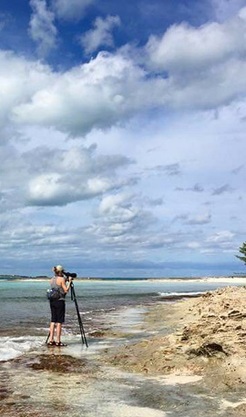 Ph.D. student Michelle Stantial scans a tropical beach for wintering piping plovers
Ph.D. student Michelle Stantial scans a tropical beach for wintering piping plovers When I first began working with piping plovers, the 2006 census had just been completed, pointing towards the Bahamas as the newest place to explore for wintering piping plovers. When the 2011 census came around, there was great excitement from my friends and colleagues who would be heading to the Bahamas, making new discoveries of important piping plover wintering locations. Five years ago, I couldn’t have imagined that I’d still be working with piping plovers today, let alone participating in the 2016 International Wintering Piping Plover Census and heading for the Bahamas.
This January, I traveled to Abaco with Todd Pover, Stephanie Egger, and Emily Heiser of the Conserve Wildlife Foundation of New Jersey, Brenden Toote from the College of the Bahamas, and Pam Prichard to begin our work. We counted a total of 172 piping plovers on Abaco, including one banded piping plover from Jamestown, North Dakota! After a week of surveys on Abaco, I traveled with Todd, Stephanie and Emily to Eleuthera where we counted a total of 82 piping plovers.
Now that the survey effort across the wintering range has revealed the Bahamas as an important wintering area, especially for Atlantic coast breeders, there are many opportunities to learn more about the wintering ecology of piping plovers. Specifically, we can now work to identify what types of habitats are favorable for roosting and foraging, allowing continued protection into the wintering grounds.
I would like to offer a very big “Thank You,” to Todd Pover for his tireless efforts to coordinate the census on both Abaco and Eleuthera and for inviting me to participate. It was truly a once-in-a-lifetime opportunity. - Michelle Stantial
 RSS Feed
RSS Feed
